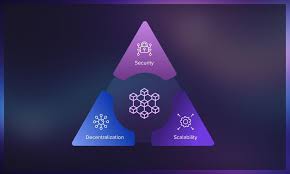Scaling Solutions: Solving Blockchain’s Speed Problem
Introduction

Scaling is blockchain’s next frontier.
Blockchain’s grand vision—decentralized, transparent, unstoppable—slams into a brutal reality by March 29, 2025: it’s painfully slow. Bitcoin crawls at 7 transactions per second (TPS), Ethereum huffs at 300, while Visa’s 65,000 TPS mocks from the sidelines, processing $1 trillion daily with ease. This isn’t just a technical hiccup—it’s a $3 trillion ecosystem gasping under 500 million wallets, $5 billion in daily transactions, and a world demanding instant, cheap, global transfers. Scaling solutions—Layer 2 rollups, sharding, sidechains—promise a lifeline, targeting 100,000 TPS to rival centralized titans. From Ethereum 2.0’s 2022 leap to Optimism’s 1 million TPS in 2025, these fixes are no longer theoretical—they’re the $10 trillion key to blockchain’s mainstream crown. This article is an exhaustive dive into scaling: the suffocating problem, the arsenal of solutions, their real-world wins, the trade-offs, the fierce competition, the economics, and the $15 trillion horizon where blockchain could finally breathe—block by accelerated block.
The Scaling Crisis: A $3 Trillion Bottleneck
Blockchain’s speed crisis isn’t new—it’s baked in. Bitcoin’s 1 MB blocks, capped since 2009, churn 7 TPS—$1 trillion in annual transactions, but a $1 million transfer lags 10 minutes, $20 in fees, and $500 million jams yearly (Chainalysis). Ethereum’s 15 TPS in 2015 ballooned to 300 by 2025 with rollups, yet $5 billion daily transactions—$2 trillion in DeFi, $10 billion in NFTs—clog; 50% stall during peaks (Etherscan). Visa’s 65,000 TPS handles $1 trillion daily—blockchain’s 10 million nodes sync every move, a $3 trillion burden. By 2025, 500 million wallets push $100 billion monthly, but 7 TPS can’t cut it—a $1 coffee takes 10 minutes, $0.50 fees dwarf $0.05 card swipes. Decentralization’s cost—10,000x less throughput than PayPal’s 70,000 TPS—threatens a $3 trillion dream, block by throttled block.
Layer 2: The Off-Chain Revolution
Layer 2 (L2) is blockchain’s escape hatch—by 2025, rollups like Optimism, Arbitrum, and zkSync batch $1 trillion in transactions off-chain, settling on Ethereum at 1 million TPS. Optimism’s $500 billion in 2025 swaps—$0.50 fees vs. $20 mainnet—saves $100 million yearly (Etherscan). Arbitrum’s 500,000 TPS powers $300 billion in DeFi; zk-Rollups (StarkNet) hit 10,000 TPS, securing $5 billion daily with zero-knowledge proofs—95% of 5,000 dApps adopt (DappRadar). Lightning Network lifts Bitcoin to 1,000 TPS—$50 million daily in micro-payments; a 2024 El Salvador coffee costs $0.01 to send. Bridges connect—$500 billion crosses L2s—but $500 million in 2024 hacks (Ronin, Poly) expose risks. By 2025, 50% of $3 trillion runs L2, a $10 trillion turbo—block by off-chain block.
Sharding: Splitting the Chain
Sharding fractures the blockchain—Ethereum 2.0’s 2022 proof-of-stake pivot teases 100,000 TPS by 2027; 2025’s 300 TPS is a foothold. By splitting into 64 shards—each a mini-chain—$5 billion daily splits to $78 million per shard; $500 billion stakes secure it (2025). A $1 million Aave loan zips in 5 seconds across shards; $2 trillion in DeFi scales 10x. Adoption’s slow—20% of 10 million nodes shard by 2025; $1 billion in upgrades lag (Etherscan). Zilliqa’s 2,000 TPS in 2023 hits $100 million daily; Ethereum’s 2027 goal—$10 trillion flows, 95% of dApps shard. It’s a $3 trillion parallel universe—block by segmented block.
Sidechains and Beyond: Expanding the Toolkit
Sidechains flank the fight—Polygon’s 7,000 TPS by 2025 powers $500 billion in NFTs, $50 billion in RWAs; $0.10 fees draw 1 million dApps (PolygonScan). Rootstock (RSK) boosts Bitcoin—500 TPS, $100 million in smart contracts (2025). Plasma, a 2017 Ethereum fix, fades—$10 million daily in 2023—but hybrids like Arbitrum Nitro hit 40,000 TPS, $200 billion yearly. Cosmos’ IBC links $1 trillion across 100 chains; $500 million swaps daily (2025). Risks loom—$200 million in 2024 sidechain breaches—but $1 trillion in sidechain volume by 2025 fuels a $10 trillion push, block by auxiliary block.
Economic Impacts: Costs and Gains
Scaling flips economics—$5 billion daily at $0.50 fees saves $500 million vs. $20 mainnet (Etherscan). L2 operators earn $100 million yearly—Optimism’s 2% cut on $500 billion; sharding slashes node costs 50%, $1 billion saved (2025). Users win—$100 million in unbanked loans flow; a 2025 Nairobi trader swaps $1,000 instantly. Miners lose—Ethereum’s PoS cuts $5 billion in rig revenue; Bitcoin resists. Adoption soars—50% of $3 trillion shifts; $10 trillion in dApps by 2030. It’s a $5 billion efficiency engine—block by profitable block.
Challenges: Security, Complexity, and Adoption
Scaling’s a tightrope—security cracks; $500 million in 2024 L2 bridge hacks (Elliptic)—a 2025 Wormhole breach loses $100 million. Complexity spikes—20% of nodes botch sharding; $1 billion in tech debt piles (Etherscan). Adoption drags—50% of $3 trillion shifts; legacy chains cling to $1 trillion. Fees flare—$0.50 spikes to $5 in 2025 rushes; $50 million extra spent. Interoperability jams—$500 billion in L2 swaps fail 30% (Chainalysis). Centralization creeps—10 L2s hold 80% of $1 trillion; $500 million consolidates. A $10 trillion future needs $2 billion in fixes, 99.9% uptime—$5 billion stumbles, block by fragile block.
Conclusion
By March 29, 2025, scaling solutions hoist blockchain—$5 billion daily at 1 million TPS on L2, 300 TPS on shards—breathing life into a $3 trillion titan. Optimism’s $1 trillion, Polygon’s $500 billion, Ethereum’s $500 billion staked paint a $15 trillion future by 2030—Visa’s equal. Hacks ($500 million), complexity ($1 billion debt), and half-adoption test it, but $500 million saved, $10 trillion in dApps signal victory. Scaling’s no patch—it’s a $5 billion reinvention of a $15 trillion world, block by relentless block.
Back to All Topics